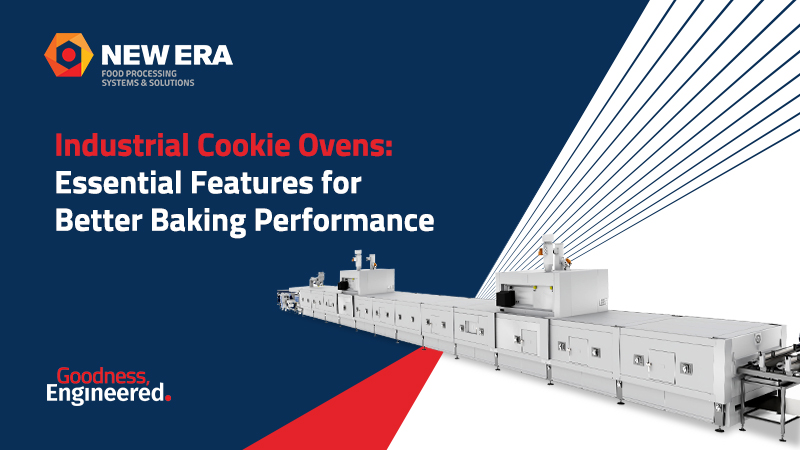With commercial baking, there is no bargaining with precision, consistency, and efficiency. To manufacture cookies at a large scale, the production line of large-scale cookie manufacturers depends on the Industrial Cookie Ovens, which convert the dough into high-quality cookies baked to perfection and size. But what is the difference between a good oven and an extraordinary oven? It is basically a mix of design creativity, heat control, energy conservation, and automation.
Top Niche players in the Industrial Cookie Oven Manufacturing industry, like New Era, have perfected this craft by incorporating technology-backed performance and reliability in their baking systems.
Let’s explore the essential features that define better baking performance and how advanced production lines exemplify this engineering excellence.
10 Must-Have Features in Next-Generation Industrial Cookie Ovens
1. Uniform Heat Distribution for Consistent Quality
The even distribution of heat all over a zone is characteristic of a high-performing industrial cookie oven. It is also caused by uneven heating, resulting in uneven coloring, variations in the texture, and uneven baking, which can affect the quality of products and the brand name.
Contemporary tunnel oven systems have also adopted technologies based on multi-zone temperature control, which provides a way to make sure that all cookies, irrespective of their location on the conveyor belt, are treated equally in terms of heat. This homogeneity ensures a similar outcome, batch after batch.
2. Energy-Efficient Heating Systems
Energy efficiency is a key financial and environmental concern in the modern manufacturing industry that is energy-conscious. Ideal industrial ovens are also developed to consume less fuel, which does not affect the quality of output.
A study estimates that process heat operations, i.e., baking, evaporation, and drying, contribute to about 59% of all energy consumed in the food processing industry. This highlights the significance of the energy-saving oven systems to lower operation costs as well as environmental effects.
The major manufacturers, such as New Era, use recirculated air technology and improved insulation in their industrial cookie ovens, which enables them to retain as much heat as possible and at least use very little energy. The result? With a lowerLower cost of operation and a smaller carbon footprint, production is not only sustainable but profitable as well.
3. Precise Temperature and Humidity Control
Baked cookies are sensitive items that require a balance between temperature and humidity to achieve the ideal texture. The control mechanisms are very specific to whether one wants to have a soft center or a crisp bite.
The new generation ovens have automated systems of humidity and temperature control, which provide operators with real-time control over baking profiles. This enables producers to tailor their production to the various types of cookies, whether butter-laden shortbreads or crisp digestives, without operator intervention.
4. High-Throughput Design with Continuous Operation
The output per hour is used as a measure of efficiency in industrial baking, and constant operation will mean maximum throughput.
Modern continuous tunnel ovens are designed to meet the production lines of high capacity, which can bake thousands of cookies in an hour and only have minimal downtimes. These ovens, paired with automated conveyor systems and synchronized feeding units, help provide continuity and smooth passage between them.
5. Automation and Smart Control Systems
In contemporary baking, the performance of the modern-day baker is not only mechanical but also smart automation. PLC systems and touch screens have now been integrated, giving operators the ability to control all the aspects of the baking cycle.
More sophisticated smart control panels ease the process of monitoring recipes, and service schedules. This not only minimizes human error but also the guarantee of uniformity across various production shifts the guarantee of uniformity across various production shifts.
6. Flexible Baking Zones for Product Variety
Bakeries usually make cookies of a variety of types: soft-baked cookies and crunchy cookies. Optimal industrial cookie ovens have a modular design, which can fit various product profiles.
The new designs of oven models incorporate the zone control, which can be an independent control of airflow or temperature of each of the sections. This means that a single line of ovens can be used to make a wide variety of cookies without significant re-mechanization, which is a vital consideration when dealing with large production plants.
7. Efficient Cooling Integration
Cooling of the food after baking is as important as the baking itself. Cracks or moisture imbalance may occur due to rapid cooling and throughput due to slow cooling.
Integrated conveyors are designed to reduce the temperature at a slow pace of the baked cookies until they attain structural integrity and optimum texture prior to being packaged.
8. Durability and Low Maintenance
Ovens used in industry should be able to withstand constant use and thermal load. That is why the quality of construction is the main point.
Manufacturers of premium-grade ovens, such as New Era, incorporate strong stainless-steel materials and modular sections of the oven that are easily cleanable and serviced. This reliability means that it is durable, hence reliable in the long term, and has less downtime- a fact that directly affects profitability.
9. Advanced Safety Mechanisms
One of the most important issues in any industrial arrangement is safety. Current-day ovens have an emergency shut-off mechanism, an automatic flame safety device, and a temperature alarm to protect the operators and equipment.
The advanced industrial baking systems are constructed with various safety features, which ensure that they comply with the global safety standard and operations despite a poor production environment.
10. Customization and Scalability
There are no two bakery operations that are identical. This is why customization is important. Reliable industrial cookie oven suppliers, such as New Era, provide oven solutions that are customized to fit a particular product need, area constraints, and manufacturing capacities.
Startup-friendly single-line systems to 8-meter industrial plant automated tunnels, they can be expanded with business needs.
Conclusion
Industrial Cookie Oven is not merely a piece of equipment in the changing world of industrial baking, but it is the cornerstone of quality, efficiency, and innovation. Precision engineering combined with energy efficiency and smart automation describes the new baking performance.
Advanced production lines and decades of experience keep New Era, your ultimate industrial cookie ovens manufacturers, redefining the requirements of industrial oven design, assisting the bakery business in attaining a stable, high standard with each and every batch.
Want to improve your baking efficiency with state-of-the-art Industrial Cookie Ovens? Contact New Era now!
FAQs
1. How do industrial cookie ovens and commercial ovens differ?
Unlike commercial ovens, which serve only small batches, industrial cookie ovens are designed to bake large quantities of cookies in automatic mode, at multiple temperatures, and with high throughput.
2. Are the cookie ovens used by New Era suitable for all cookies?
Yes. The ovens of New Era have adjustable space to bake, therefore, allowing the manufacturer to bake various varieties of cookies, such as soft, chewy, or crispy cookies, yet they all move through the same conveyor.
3. What makes New Era ovens energy efficient?
The New Era ovens have a recirculated air system, insulated chambers, and intelligent heat recovery control to ensure the minimum use of fuel and, at the same time, achieve the best performance regarding baking.
4. Is it possible to incorporate New Era industrial cookie ovens with the production lines?
Absolutely. New Era has modular and scalable designs that can easily be combined with mixers, conveyors, cooling systems, and packaging lines to give the business a smooth flow of production.


